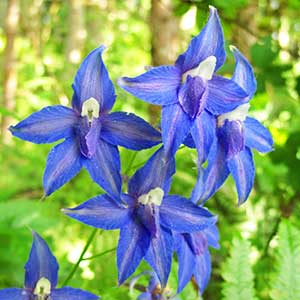Delphinium trolliifolium
Delphinium tricorne
Columbian larkspur, cow-poison, poison delphinium, poison larkspur
dwarf larkspur, rock larkspur
(40-)60-120(-180) cm;
base usually reddish, glabrous to puberulent.
20-60 cm;
base often reddish, nearly glabrous.
blade ± pentagonal, 4-8 × 7-16 cm, margins ± incised, nearly glabrous; ultimate lobes 0-9, width 15-30 mm (basal), 5-20 mm (cauline), widest at middle or in proximal 1/2.
blade round, 2-8 × 4-12 cm, nearly glabrous; ultimate lobes 3-18, 5 or more extending more than 3/5 distance to petiole, width 2-10 mm (basal), 4-10 mm (cauline), widest at middle or in proximal 1/2.
(5-)14-40(-75)-flowered, ± open, at least 2 times longer than wide;
pedicel 1-4(-9) cm, puberulent to glabrous;
bracteoles (2-)6-12 mm from flowers, green, linear, 5-9(-14) mm, puberulent.
5-15(-30)-flowered, less than 3 times longer than wide;
pedicel 1-2.5 cm, puberulent;
bracteoles 1-4(-6) mm from flowers, green, linear, 3-5 mm, puberulent.
sepals dark blue, glabrous, lateral sepals spreading, (8-)14-21 × 5-9 mm, spurs straight or downcurved at apex, within 20° of horizontal, (10-)16-23 mm;
lower petal blades covering stamens, 5-10 mm, clefts 1.5-3 mm;
hairs sparse, mostly near junction of blade and claw, centered or on inner lobes, well dispersed, yellow.
sepals deep bluish purple to pink or white, puberulent, lateral sepals spreading, 11-19 × 4-7 mm, spurs straight, within 30° of horizontal, 13-16 mm;
lower petal blades ± covering stamens, blue, except sometimes in white-flowered plants, 6-10 mm, clefts 0.5-2 mm;
hairs sparse, mostly centered near junction of blade and claw, white.
(15-)23-34 mm, 3.8-5.5 times longer than wide, glabrous.
14-22 mm, 4-4.5 times longer than wide, nearly glabrous.
unwinged;
seed coats smooth.
unwinged;
surface of each seed coat cell with 1-5 small, swollen, elongate, blunt, hairlike structures, barely visible at 20x, otherwise smooth.
= 16.
= 16.
Delphinium trolliifolium
Delphinium tricorne
Delphinium trolliifolium occurs in the northern Coast Range of California, the Columbia River Valley to just east of Mt. Hood, and the Willamette Valley of Oregon upstream to Lane County. California plants differ somewhat from Oregon plants in pubescence patterns and habitat preferences. Further study may show that two entities are involved here.
Hybrids between Delphinium trolliifolium and D. decorum, D. menziesii subsp. pallidum (D. ×pavonaceum Ewan, Peacock larkspur), D. nudicaule, D. nuttallianum, and D. nuttallii are known. Delphinium trolliifolium is likely to be confused only with D. bakeri. Refer to discussion under that species for differences.
(Discussion copyrighted by Flora of North America; reprinted with permission.)
Delphinium tricorne is the most commonly encountered larkspur east of the Great Plains.
The Cherokee prepared infusions of Delphinium tricorne to ingest for heart problems, although they believed the roots of the plant made cows drunk and killed them (D. E. Moerman 1986).
(Discussion copyrighted by Flora of North America; reprinted with permission.)


